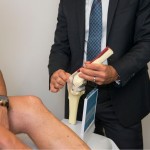
Arthritis or a previous hip injury may lead to extreme pain or even cause inability to walk. Before surgery is recommended, there are non-surgical treatments that need to be considered, however when these methods don’t work, a total hip replacement may be necessary.
Total hip replacement is the process by which your natural hip joint is replaced by an artificial joint made of metal and a bearing made of ceramic or plastic implants. The aim of hip replacement surgery is to replace the bone ends that are in contact with each other with artificial material (prosthesis) so that the patient no longer experiences pain. Hip joint replacement surgery can be very successful for many patients in restoring total mobility and enabling their ongoing independence.
How do you know if you are a candidate for a total hip replacement? Consider answering the following questions:
- Have you tried and are not getting results from treatments such:
- Anti-inflammatory medication?
- Physiotherapy?
- Mild to moderate exercise such as aquarobics or walking?
- Have you tried or are you using a walking stick or other methods help you to get more mobile?
- Is your hip pain keeping you awake at night?
- Is it severely impacting your quality of life? E.g. are you finding it hard to sit or lay down?
- Is your hip pain causing other health problems?
- Are you between 60 and 80? – Although most hip replacement patients are in this age surgery is not limited to this age bracket.
If you have answered yes to most of the above questions and you feel you have tried every method to help improve your hip mobility, it may be worthwhile visiting an Orthopeadic surgeon to discuss a total hip replacement.
There are a number of different ways of entering the hip to perform the same operation – direct anterior, posterior and anterolateral.
Dr Shidiak has extensive experience in all of the most common approaches. His preference is to use the minimally invasive direct anterior approach technique wherever possible (see “anterior approach hip”). This approach does not cut any muscles and allows quicker recovery in the early post-operative period. For more information or to discuss your condition, please contact Dr Shidiak.


